I’ve been reading a lot lately about trees; about the forest community and how trees communicate with each other by means of thin filaments of fungi that spread under the forest floor. It seems that these fungal networks convey crucial information from one tree to another, including an alert that a tree is sick. Other trees then respond by sending healthy enzymes through those networks to the ailing tree. Trees appear also to send messages to each other in the air. For example, Suzanne Simard, a professor of forest ecology at the University of British Columbia, has observed how a Douglas fir that had been injured by insects sent chemical warning signals to a ponderosa pine growing nearby. The pine tree then produced defense enzymes to protect against the insect.*
Hers and other forest ecologists’ research indicate that a forest is a supportive, integrated society. Richard Powers has described it as “The Overstory”** by which I believe he means not just the forest canopy but an “uber-story”, an archetype for healthy human societies.
As is true in human society, members do eventually die. A tree will fall in the forest and whether or not it makes a sound, as the quixotic question asks, it does have impact. So that, when that tree falls and dies, the answer is “leave it there.” It may be dead, but it’s life, paradoxically, isn’t over. Indeed, its contribution to the ongoing health of the forest will be as important as when it stood straight and tall.
On my walks, I might find a newly fallen trunk that looks like this: dead wood.
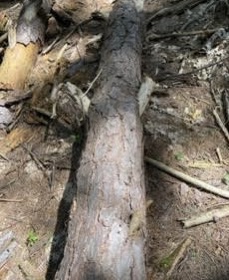
Further on, I notice one that may have been lying there many years looks like this: indications of soft green moss starting to spread with bright orange fungus making a home.
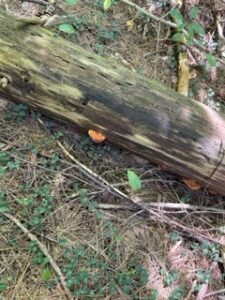
A bouquet of fungi attach to this much older log, feeding off the nutrients of the decaying wood as the ground beneath starts to digest it: 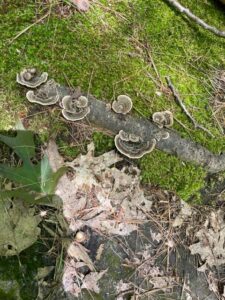
Farther along, as I make my way through the woods I see what I would never have seen in my lifetime had what I’ve shown you so far been all the same log, for this fallen beauty came to earth long before I was born over eighty years ago:
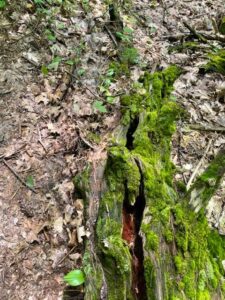
Look closely at the bottom left where you’ll notice one small green leaf emerging from its moss-covered host. This former tree has now become a fully mature nurse log, so called because it feeds young lives. Soft decaying wood provides nutrients for mushrooms and other fungi, for moss and green leaves that promise future trees. There are crevices and hollows where insects feed, snakes escape the sun’s rays and small animals find cover. A nurse log which, a hundred plus years ago, was a member of its forest community, is now its own community. A community vital to the preservation of a healthy forest.
At what moment do we say that a nurse log is dead? Many human lifetimes have passed since it fell to earth. It will soon sink forever into the forest floor and disappear.
Still, its life goes on, as evidenced in this final photograph. 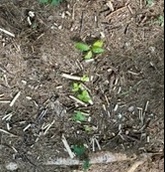 .
.
We can no longer see the nurse log but she’s not done yet. Here, this stretch of four or five small green leaves march along in a straight line precisely because they are rooted in their nurse log below.
Several paragraphs ago, I wrote that the forest community could be a model for a healthy human way of life, or, as Richard Powers writes, an Overstory. Stretch that metaphor a bit and apply it to the nurse log. A tree in the community falls, but it does not die. I submit that the “death” of that tree is simply, as we have seen, a different form of life. Might it not also be a model for a healthy human way of death?
What if, when our bodies die, we become nurse logs? Very literally, that can be so with a green burial, an increasingly popular practice that allows one’s body to be buried wrapped in a shroud, usually in dedicated green cemeteries, often in forests. Like the fallen tree, our bodies will nourish the living forest for years and years. What an incalculable privilege and gift to planet earth that will be!
As tree communicates to tree, so too do we link together in human community. Our connections don’t die with us. In a way, we have been nurse logs all along; nurturing, teaching, loving, encouraging, modeling behaviors and ways of living in some fashion for those whose lives we have touched.
Although eternal life might seem to be a promise only to those who believe in the resurrection of Jesus; as the forest teaches and nurse logs show, we are beings with a presence not only when we are in our bodies. I may call it Spirit, others will say Soul, Qui/Chi or Energy; the name isn’t important. All we have to do is believe the promise seen in that final photo where tender green shoots defy death: a visible sign of an invisible truth.
Thoreau “went to the woods” to learn how to live deliberately, to learn what it had to teach. Can we not also go to the woods to learn how deliberately and lovingly it might be to die?
For further reading:
*Finding the Mother Tree by Suzanne Simard.
**The Overstory, a novel by Richard Powers
The Hidden Life of Trees, by Peter Wohlleben
Walden, by Henry David Thoreau
